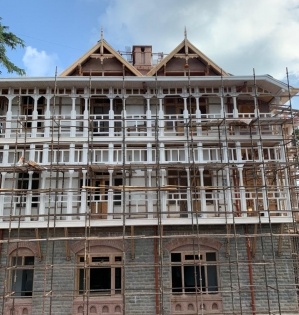Another blast from colonial past in 'Queen of Hills'
By IANS | Published: July 18, 2021 08:18 AM2021-07-18T08:18:03+5:302021-07-18T08:35:55+5:30
Shimla, July 18 A blast from the colonial past will soon greet visitors to Shimla, the erstwhile summer ...

Another blast from colonial past in 'Queen of Hills'
Shimla, July 18 A blast from the colonial past will soon greet visitors to Shimla, the erstwhile summer capital of British India. The government is reconstructing Bantony, the 129-year-old sprawling estate comprising grand structures near Scandal Point on the famous Ridge, in its original rich Gothic-style architecture with an outlay of Rs 25 crore.
The entire estate, comprising two grand wooden buildings, decaying for many decades, was purchased by the government in 2017 for Rs 27.84 crore, fearing it might be lost like other heritage structures.
The buildings are now being tastefully raised with joint funding from the Asian Development Bank and the state government under the Infrastructure Development Investment Program for Tourism.
The complex will showcase the state's rich culture and traditions in a world-class museum, two art galleries and a cultural centre, housed in both the two-storey buildings, an official with the state Tourism Department told . It will also have a tourist information centre.
The target for completing the construction work is December, but it is likely to be extended by a month or two owing to shortage of labour amid the Covid-19 pandemic, he said.
Bantony was the summer palace of the erstwhile Maharaja of Sirmaur, whose coat-of-arms can still be seen in some portions in the newly installed cast-iron railing in front of the complex.
The cast-iron railing and the original gate outside the building were cast in Nahan Foundry and were erected in 1902-03.
"In the previous structures the use of wood was more than 60 per cent and the buildings were built in the 'dhajji' style. In the upcoming structures the original character and grace have been maintained, keeping in mind their glory and history," a construction engineer, who wished not to be quoted as he is not authorised to speak to the media, told .
According to him, even in the rebuilt structures the use of wood is 60 per cent and the walls are built in the 'dhajji' style of varied lath and plaster.
The buildings are being restored and conserved keeping in mind its original Gothic style architecture, he added.
Besides art galleries and a museum, the complex, ringed around by thick deodar trees, will have a cafeteria-cum-restaurant and walking trails.
After the construction, the Tourism Department will hand over the property to the state Language, Art and Culture Department to showcase Shimla's grand heritage to the visitors.
Officials told that Bantony, on completion, along with the newly restored British-era Town Hall and Gaiety Theatre which all lie on the historic Ridge an open space just above the Mall extending to Grand Hotel in the west and the Lakkar Bazaar in the east will be a favourite haunt of those out for a stroll to see the town's legacy.
Like many Raj buildings in Shimla, Bantony's original architectural style was somewhat eclectic part mock-Tudor, part chalet and crowned with sloping roofs with mini-towers. The architect was said to be T.E.G. Cooper.
Before its construction in 1880, the place had a rickety cottage belonging to Captain A. Gordon and housing some army officers.
After 1957 the Bantony building had been the headquarters of the state police. It was vacated in 2013 after a court case.
Officials say due to inadequate repairs, lack of financial resources of the previous owners and limited understanding of heritage preservation, the building was in a dilapidated state for years.
Even the local municipal corporation had warned that if preventive measures were not taken to preserve it, Bantony would soon be just a name in the history books.
Histor and old-timers are happy with the restoration and preservation of Shimla's traditional glory, saying it will be another blast from the grand colonial past.
"Shimla's grand heritage showcases our country's rich history. The restoration of Bantony on the lines of the Gaiety Theatre and the Town Hall is a right step to protect the British heritage and its rehabilitation is very relevant and appropriate," Raaja Bhasin, co-convener of the state chapter of Indian National Trust for Art and Cultural Heritage, told .
Octogenarian Naresh Sud, who was born and brought up in the Queen of Hills, as Shimla was fondly called by the British colonial rulers, said most of the relics of the British era are either crumbling or being reduced to rubble.
"Now this building too will soon get back its original glory," added Sud pointing towards Bantony.
Officials say to showcase the history of Shimla over the years as the once tiny village metamorphosed to become the summer capital of the British Raj in India, the government is planning a laser light-and-sound show every evening for the tourists in Bantony.
Shimla was the summer capital of the British rulers between 1864 and 1939.
Shimla's history goes beyond British India.
Mahatma Gandhi visited Shimla several times in the days leading to the country's independence in 1947. On some occasions, leaders like Sardar Vallabhbhai Patel, Jawaharlal Nehru, Madan Mohan Malaviya and Lala Lajpat Rai accompanied him.
"A laser light-and-sound show at the Cellular Jail
Disclaimer: This post has been auto-published from an agency feed without any modifications to the text and has not been reviewed by an editor
Open in app